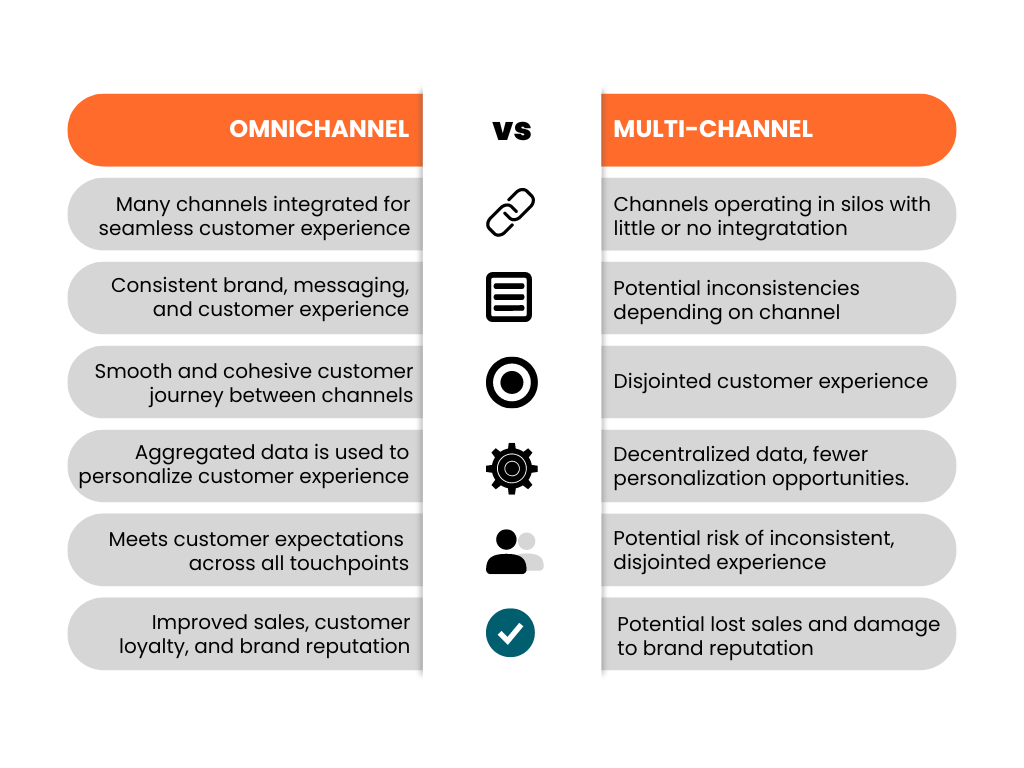Omnichannel Marketing Explained: The eCommerce Marketer's Must-Read Guide

Commerce can be a cutthroat business, and mastering omnichannel marketing isn't just smart—it's survival.
Imagine a frustrated shopper bouncing between disconnected online and offline interactions, only to find solace with a competitor who gets it right. With shoppers expecting seamless transitions across both realms, sellers must sync every touchpoint for a flawless journey.
The stats speak volumes:
- Sellers with the strongest omnichannel strategies retain 89 percent of customers, while those with weak strategies keep just 33 percent.
- Merchants that don’t use omnichannel strategies increase average sales revenue 64 percent slower than those that do.
- Omnichannel shoppers have a 30 percent higher customer lifetime value (CLV) than single-channel shoppers.
Whether you’re just starting your eCommerce business or a seasoned seller, read on to learn more about omnichannel marketing, how to get started, and the key trends and tech that will help you succeed.
What is omnichannel marketing?
Omnichannel marketing is a strategy that integrates various channels—like websites, mobile apps, social media, email, and physical stores—to create a unified customer experience. It ensures consistency across touchpoints, acknowledging that customers interact with brands across multiple devices. This strategy tailors experiences at every stage—online, in-store, and on mobile devices.
Data shows 73 percent of consumers will likely switch brands if they experience inconsistency across channels. Omnichannel marketing tackles these challenges with:
- Integrated data: Centralized customer data for personalized marketing efforts.
- Channel consistency: Coordinated experiences across all channels.
- Optimized customer journeys: Refined touchpoints for less churn and higher customer lifetime value (CLV).
In essence, omnichannel marketing centralizes data and helps sellers optimize the customer journey with consistent, personalized experiences that drive engagement, loyalty, and sales.

Why eCommerce sellers need omnichannel marketing
Omnichannel marketing is a game-changer for brands that want to thrive. Consumers expect a cohesive experience across all channels, whether browsing products online, engaging with your brand on social media, or visiting your physical store.
Sellers can use omnichannel marketing to build credibility, trust, and loyalty by providing a unified, consistent experience across all customer touchpoints. Data shows 71 percent of consumers prefer brands that offer a consistent experience across channels.
The advantages are also clear operationally. Sellers that embrace omnichannel tactics see increased conversion rates, with customers spending four percent more in-store and 10 percent more online. Additionally, omnichannel customers have higher average order values (AOVs) and CLVs, which help boost profitability. Omnichannel strategies also help sellers stand out in a crowded marketplace.
Omnichannel marketing vs. multichannel marketing: What’s the difference?
Understanding the difference between omnichannel and multichannel marketing is essential. Let's break it down:
- Omnichannel marketing cohesively integrates various channels and creates a consistent experience across online, in-store, mobile app, and social media interactions.
- Multichannel marketing uses multiple channels to reach customers but lacks the unified approach of omnichannel strategies. Each channel operates independently, often leading to disjointed customer experiences and inconsistent messaging.
Imagine a customer receiving conflicting information about a product online versus in-store. It's a recipe for confusion and frustration.
While multichannel marketing offers sellers flexibility in reaching customers, omnichannel marketing stands out by integrating data and channels. This helps sellers deliver more personalized experiences across offline and direct-to-consumer (DTC) channels that meet customer expectations and lead to lasting success. Not meeting those expectations risks losing sales and damaging your brand's reputation.

How to jumpstart your business with omnichannel marketing
Phase 1: Plan and prepare
Creating a solid foundation for your omnichannel marketing is key. Here’s how to start:
- Define your strategy and goals: To purposefully steer your efforts, outline your objectives, and develop an omnichannel strategy aligned with your brand identity, target audience, and business goals.
- Understand your audience: Conduct thorough research on your audience’s behaviors across channels. Analyze demographics, preferences, and purchasing patterns to create detailed customer profiles that can guide your omnichannel approach.
- Evaluate your channels: Assess the performance of your channels based on factors like reach, engagement metrics, and conversion rates. Identify high-performing channels and areas for optimization, and explore new channels that support your strategy.
- Tune into trends: Stay updated on industry trends, emerging technologies, and innovative tactics shaping consumer behaviors. Incorporate relevant trends and tools, like AI-driven personalization and social media features, to keep your approach adaptable.
Phase 2: Implement and integrate
Next, put your omnichannel strategy into action.
- Choose your technology: Invest in tools like CRM software, marketing automation platforms, and data analytics tools. Explore omnichannel marketing platforms like Klaviyo, Gorgias, and Attentive to manage campaigns across multiple channels alongside tools like AfterShip Tracking and AfterShip Returns for optimized post-purchase experiences.
- Integrate your data: Centralize your customer data for seamless cross-channel communication. Robust data integration solutions sync customer information across touchpoints and help you ensure consistent messaging and experiences.
- Personalize your content: Use your customer data and segmentation strategies to create targeted content that boosts engagement and conversions. Craft tailored messaging and offers across emails, social media, and website content to foster meaningful connections.
Phase 3: Measure and optimize
With your strategy and execution plans in place, measure your performance and continually refine your approach for omnichannel success.
- Define your metrics: Set KPIs like conversion rates, customer engagement, and ROI to monitor the effectiveness of your omnichannel campaigns and pinpoint areas for improvement.
- Analyze your data: Dig into your data to uncover insights into customer behavior and preferences, then refine your strategies and optimize the customer experience.
- Continuously test: Embrace a culture of continuous testing and experimentation through A/B testing, user testing, and customer surveys to drive better results.
- Prioritize personalization: Use customer data to tailor your messaging, offers, and interactions across channels to boost satisfaction, loyalty, and overall success.
By following these phases, you'll be well-equipped to adapt to evolving customer needs and preferences and drive meaningful engagement and growth for your business.
Omnichannel marketing examples
Explore how leading brands use omnichannel marketing to deliver engaging customer experiences across online and offline channels.
Starbucks
Starbucks seamlessly integrates its mobile app with its physical stores to provide customers with a cohesive experience. Customers can order ahead through the app, customize their drinks, and earn rewards while enjoying a consistent brand experience—whether online or in-store.

Nike
Nike uses omnichannel marketing by combining its eCommerce platform with interactive in-store experiences. The Nike app allows customers to browse products, customize shoes, and access exclusive content. At the same time, Nike's physical stores offer services like gait analysis and product trials, which create a consistent and engaging brand experience.

Walmart
Walmart uses omnichannel marketing to bridge the gap between its online and offline channels. Customers can shop for groceries, electronics, and household essentials on Walmart's website or app and then choose from options like home delivery, curbside pickup, or pickup lockers at select locations.

Omnichannel marketing technologies and trends
Data centralization is at the core of effective omnichannel marketing. By consolidating customer data, sellers can offer consistent, personalized experiences across all channels and nurture stronger customer relationships that drive engagement and sales.
Beyond centralizing data, let's explore some technologies and trends that are shaping the future of omnichannel marketing.
Cutting-edge technologies for omnichannel marketers
- Artificial intelligence (AI): AI-powered solutions enable personalized experiences and predictive analytics, driving engagement and retention rates by delivering tailored interactions that resonate with individual customers.
- Augmented reality (AR) and voice commerce: These technologies reshape the omnichannel shopping experience by offering immersive and convenient solutions, such as virtual try-ons and streamlined purchasing through voice assistants like Amazon's Alexa.
- Social commerce: Using platforms like TikTok for shoppable content, sellers can extend their reach, drive conversions, and encourage community engagement across multiple channels, enhancing the omnichannel shopping journey.
Key omnichannel marketing trends
- AI-driven hyper-personalization: Using advanced AI algorithms and big data analytics, brands are creating hyper-personalized experiences that go beyond basic segmentation. These solutions adjust content and offerings dynamically in real time, providing customers with highly relevant and timely interactions across all channels.
- Unified commerce: Sales channel integration offers cohesive shopping experiences, empowering customers to transition effortlessly between online platforms and physical stores while maintaining continuity in their interactions.
- Proactive customer engagement: Brands are shifting towards proactive customer service, using data analytics and predictive technologies to anticipate and address customer needs before they arise, ultimately enhancing overall satisfaction and loyalty.
Key takeaways
Embracing omnichannel marketing isn't just a smart move—it's essential for success. Blending online and offline experiences ensures consistency and cohesion across all touchpoints with your brand.
By seamlessly integrating online and offline experiences, synchronizing touchpoints, and using cutting-edge tools and technologies, sellers can improve customer satisfaction, drive engagement, boost revenue, and stay ahead in the competitive world of eCommerce.
Want to learn more about omnichannel marketing strategies? Subscribe to have them delivered straight to your inbox.

